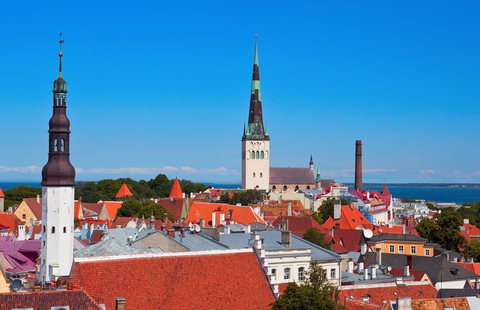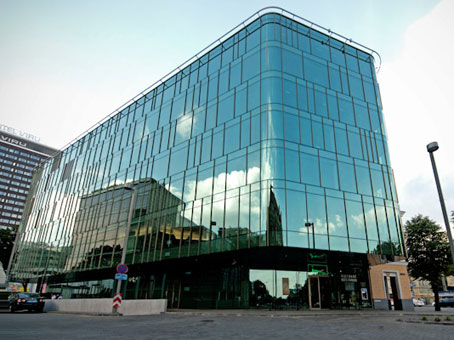
[Updated Oct 2020] A guide to serviced offices and office space to rent in Tallinn as well as general information that may be useful if you are considering renting office space in the city.
For further Tallinn offices information or to search office space to rent in Tallinn just click. Or contact us for any office space search query.
History & Geography
Estonia’s capital and the largest city in the country sits on the northern coast of the of Estonia on the Gulf of Finland. It lies 50 miles south of Helsinki and east of Stockholm on the picturesque Lake Ulemiste. The city started life as a fortress built in 1050 which protected the trade route between Scandinavia and Russia. Dubbed Reval, the city which grew up around the fortress fell into the hands of the Danes early in the 13th century. In 1258 Reval joined the Hanseatic League, a powerful mercantile alliance of Germanic cities and states. In 1346 Reval was sold to the Teutonic Knights, who further fortified the city due to its important trading location. During this time the city’s population increased to more than 8,000 people. By the year 1561 Reval had converted to Lutheranism and had become a possession of Sweden. Reval remained a Swedish city until the Great Northern War of the early 18th century when it fell under the auspices of Imperial Russia. During this time the city’s port increased in importance and prosperity. Around this time the city became referred to as Tallinn, meaning ‘Danish castle’ in Estonian. After WWI a struggle for Estonian independence began, later known as the Estonian War of Independence. The war as waged by the Estonian Army the White Russian Army and the British Army against the Russians. In 1920 the independence of Estonia was recognized by Russia in the Tartu Peace Treaty signed on February 2nd. Immediately Tallinn became its official capital. During WWII the country was occupied by Germany from 1941 to 1944 and afterwards was annexed by the USSR. In 1991 Estonia once more became independent from Russia and Tallinn was reestablished as the country’s official capital. Today Tallinn is one of the most dynamic and culturally attractive cities in the region.
Economy
Tallinn is the economic hub of Estonia and has a rich and diversified economy. The city’s port is an important driver of its economy and one of the busiest ports on the Baltic Sea. The Port of Tallinn, a company owned by the state, runs five ports which all make up a whole. However, of late Tallinn has encouraged the growth of other industries. One of these is information technology. The city is home to Skype’s software development centre, which is a major employer in the city. Over the last decade or so Tallinn has earned the name ‘the Silicon Valley of the Baltic’. The city is famous for its Institute of Cybernetics which has spawned many profitable start-ups. Tallinn has a partnership agreement with Los Gatos, California, a town at the centre of the original Silicon Valley. As well as IT, Tallinn has strong sectors in light, textiles, various service sectors, and the food industry. Because Tallinn is the capital of Estonia the government is also a major employer in the city. Over half of Estonia’s GDP is from Tallinn, underlining how important the city is for the country’s economy as a whole.
Tourism & Culture
Like many other capital cities of Eastern Europe Tallinn has a rapidly growing tourism industry and has become a favoured destination for Europeans going on city breaks. Tallinn has retained much of its old architecture and history, which is one of its most attractive elements for visitors. Favoured destinations in Tallinn are the two old towns, Toompea, and Lower Town. Toompea, also known as Upper Town, is a walled section of Tallinn featuring its own bastions. It is the location of the Alexander Nevsky Cathedral as well as the Estonian Royal Palace which now houses the Estonian Parliament. Lower Town is famous as one of the most caringly preserved old towns in Europe. The Town Hall Square and St Olaf Church Tower are must-sees for any history buff. Another popular landmark is Kadriorg Palace, the former palace of Peter the Great. This houses the Art Museum of Estonia, one of the finest art museums in the region. The coastal area of Pirita is yet another favoured destination for tourists who often hire boats to take out on the Pirita River. For those in search of more modern pursuits, the modern centre of Tallinn hosts a bustling nightlife with dozens of restaurants, bars, and clubs.
Transportation
Tallinn is served by the Lennart Meri Tallinn Airport, which is only four kilometres from the Town Hall Square. The airport is reachable via bus, taxi, and railway. Recently the airport underwent a major expansion which was finished in 2008. There is also a helicopter service every day which goes between Tallinn and the Finish capital of Helsinki. Tallinn is also connected to several cities via ferry. Ferries run services to Helsinki, Stockholm, St Petersburg, and Mariehamn. The city of Tallinn itself has a comprehensive bus service, trams, and a trolley-bus.

The office market in Tallinn has been relatively stable of late and further improvement is expected as the economy continues its slow but steady upturn. However, no major changes are expected soon. Currently, the average rental rates for Grade A office space in the city stand at approximately EUR 13 per square metre per month. The vacancy rate is at six percent, a number that is not expected to change drastically in the coming years. Some analysts have noted that tenants paying over EUR 10 per month are expecting incentives like better parking, planning, location, and so forth.
Our office space search, advisory and acquisition services are FREE, always. We are globally regulated by the Royal Institution of Chartered Surveyors (RICS) ensuring the highest standards of commercial property advice and service at all times.
